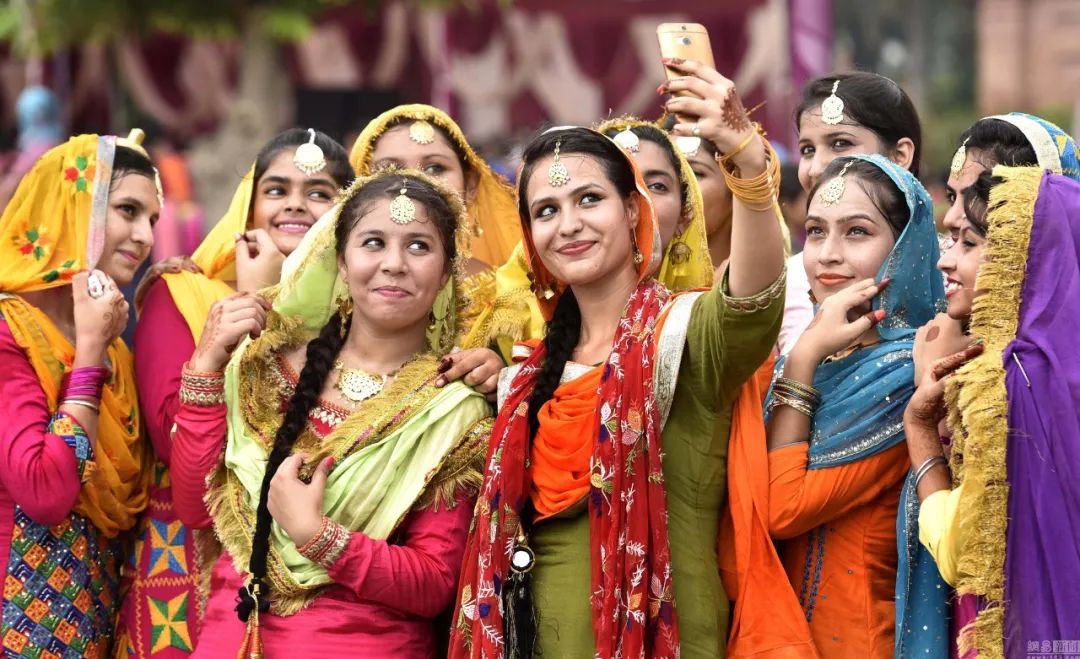
背景介绍:
随着印度经济的崛起,其国际旅行人数和消费能力大幅增长。印度游客在全球的影响力逐渐显现,特别是在东南亚国家,如泰国,印度游客数量持续攀升,成为当地旅游业的重要推动力。相比之下,西方国家在吸引印度游客方面行动迟缓,签证政策繁琐,导致印度游客更倾向于前往距离更近、签证更便利的国家旅行。泰国等国抓住机遇,取消对印度人的签证要求,吸引了大量印度游客,促进了旅游业的发展。
From Bangkok to Dubai
从曼谷到迪拜
Indian tourists are conqueringthe world 印度游客正在征服世界
Indian express on a Friday evening is always bustling. Diners from all corners ofIndia dig in to kebabs and curries. Kingfisher, an Indian lager, flows freely,and Bollywood music blares from the speakers. 星期五晚上的印度快车总是格外喧嚣。来自印度各地的食客们大口品尝着美味的烤肉串与香气四溢的咖喱。印度的翠鸟啤酒在众人手中流转,伴随着扬声器里传出的宝莱坞经典旋律,将夜晚点缀得更加热闹非凡。
A similar (if slightly more abstemious) scene plays out down the road at Radha Krishna, a vegetarian eatery. One might be in any of a dozen cities in India. But this paratha party is happening in Bangkok. 路边的拉达克里希纳素食餐厅同样上演着一幕类似的景象,尽管氛围稍显内敛与克制。这样的场景,仿佛可以在印度的任何一个大城市中遇见。但这场帕塔派对是在曼谷举行的。
India’s economic rise has lifted millionsout of poverty and given the country greater geopolitical heft. Less obvious isthe effect of its growing consumer class on other countries. Internationaldepartures from India more than doubled, to 27m, in the decade to 2019. 印度的经济崛起不仅让数百万人摆脱了贫困的束缚,更为该国在全球地缘政治舞台上赢得了更为举足轻重的地位。相比之下,其日益庞大的消费阶层对其他国家的影响则不那么明显。在2010年至2019年的十年间,离开印度的国际旅行人数实现了翻番,达到了惊人的2700万。
Overseas spending by Indian travellers tripled between 2010 and 2023, to $33bn. One forecast suggests it will jump to $45bn next year. Driving this is a mix of demography and economics. 更令人瞩目的是,从2010年至2023年,印度游客在海外的支出更是实现了三倍的增长,总额高达330亿美元。一项预测显示,这一数字将在明年继续攀升,预计将达到450亿美元。推动这一趋势的,既有庞大的人口基数,也有经济的蓬勃发展。
People aged between 25 and 34 are keenest on travel; a fifth of the population will age into that group soon. The middle class is expected to be twice as big by 2047. The number of valid Indian passports grew from 52m a decade ago to 93m this year. 25岁至34岁的年轻人群是旅行的主力军;同时,印度即将迎来五分之一人口步入老年的时代。据预测,到2047年,印度的中产阶级规模将是现在的两倍之多。此外,有效的印度护照数量也从十年前的5200万激增至今年的9300万。
By 2040 the number of internationaldepartures could hit 80m or even 90m, reckons McKinsey, a consultancy. That isnot far off the 104m Chinese who went abroad in 2019. 咨询公司麦肯锡预测,到2040年,印度的国际离境人数可能会达到8000万至9000万的规模,这一数字已与中国2019年赴海外旅游的1.04亿人相差不远。
But Chinese consumers are increasingly staying at home; their foreign travel is not growing as fast as it used to. Indians are thirsty to see the world. Unlike the Chinese at a similar stage, however, they are not rushing to Europe. It is countries closer to home that are reaping the rewards. 然而,中国消费者越来越倾向于在国内享受假期,他们出国旅游的增长速度已不如往昔。相比之下,印度人则满怀对世界的好奇与渴望。但与他们处于类似发展阶段的中国人不同的是,印度游客并不急于前往 欧洲。因此,那些与印度距离更近的国家成为了受益者。
In recent decades, as China became theworld’s biggest source of tourists, Western countries adjusted. Governmentssimplified visa processes, airports installed signage in Mandarin, and shopsstarted accepting Chinese payment platforms. But they have been slower to court Indian tourists. Meanwhile, Middle Eastern and South-East Asian countries are racing ahead. 近几十年来,随着中国跃升为全球最大的游客来源国,西方国家纷纷进行了相应的调整。政府简化了签证流程,机场增设了中文标识,商店也开始接受中文支付平台。然而,在吸引印度游客方面,这些国家的行动却显得相对迟缓。
Thailand and Malaysia have suspended visa requirements for Indians. Other countries are recruiting Bollywood stars as brand ambassadors: Abu Dhabi tourism has landed Ranveer Singh, who used to promote Switzerland; Dubai has roped in Saif Ali Khan and Sara Ali Khan, a father-and-daughter duo. The countries that welcome Indians will enjoy both the economic benefits and the cultural soft power that tourism affords. 与此同时,中东和东南亚国家则抓住了这一机遇,迅速迎头赶上。泰国和马来西亚已经暂停了对印度人的签证要求,而其他国家也在积极招募宝莱坞明星担任品牌大使,以吸引更多的印度游客。例如,阿布扎比旅游业聘请了曾经为瑞士代言的兰维尔·辛格,而迪拜则请来了赛义夫·阿里·汗和萨拉·阿里·汗这对父女二人组。那些欢迎印度人的国家,无疑将享受到旅游业带来的丰厚经济利益以及文化软实力的提升。
For lessons on how to do it, look to theSouth-East Asian countries that were early to grasp India’s potential. They arenow redoubling their efforts in hopes of replacing China’s flagging numbers. 要了解如何做到这一点,我们可以从东南亚国家身上汲取经验。这些国家很早就意识到了印度的潜力,并一直在努力抓住这一机遇。如今,他们更是加倍努力,希望能在中国游客数量不断下滑的背景下,取代其原有的地位。
In 2019 Chinese accounted for 11m of Thailand’s 40m overseas visitors. Last year they were a mere 3.5m out of 28m. Indians, by contrast, keep coming. A decade ago around 1m visited annually; that level was already reached in the first half of 2024. Many are on their inaugural trip abroad. 2019年,在泰国4000万海外游客中,中国游客占据了1100万的重要份额。然而,去年这一数字已锐减至350万。相比之下,印度游客的数量却在持续攀升。十年前,每年约有100万印度游客到访泰国;而到了2024年上半年,这一数字已经达到了之前的全年水平。其中,许多人都是首次出国旅行。
Margaux Constantin of McKinsey thinks Bangkok could take over from Dubai as Indians’ number-one leisure destination this year. Thailand’s tourism ministry estimates that Indians generated 63bn baht ($1.8bn) in 2023, or around 0.4% of Thai GDP. 麦肯锡的玛戈·康斯坦丁认为,曼谷今年有望取代迪拜,成为印度游客最喜爱的休闲目的地。据泰国旅游部估计,印度游客在2023年为泰国创造了630亿泰铢(约合18亿美元)的收入,约占泰国GDP的0.4%。
Thailand appeals to Indians because it ischeap, easy to get to and welcoming. The last point is most important. TheIndian passport is a weak document, providing visa-free or equivalent entry tojust 58 countries, mostly small islands in the Pacific and Caribbean. EvenCubans and Belarusians have better access to the world. 泰国之所以对印度游客具有如此大的吸引力,主要得益于其低廉的价格、便捷的交通以及热情好客的氛围。而最后这一点尤为重要。印度护照在国际上的认可度相对较低,仅能提供58个国家的免签证或同等待遇入境,其中大部分是太平洋和加勒比海的小岛屿国家。甚至古巴人和白 俄罗斯人在国际旅行方面的机会也比印度人更多。
Last year Thailand lifted all visa requirements for Indians, a privilege usually reserved for rich Western countries. Visitor numbers immediately shot up. Iran, Kenya and Sri Lanka have also abolished visas for Indians. More modest loosening helps, too. When Azerbaijan launched an e-visa programme for Indians in 2017, annual arrivals tripled within a year and doubled again the next year, to 160,000. 去年,泰国取消了对印度人的所有签证要求,这一特权通常只针对富裕的西方国家公民。前往泰国的印度游客数量随即激增。此外,伊朗、肯尼亚和斯里兰卡也取消了印度人的签证要求。更为适度的放松政策同样有助于吸引印度游客。例如,当阿塞拜疆在2017年为印度人推出电子签证计划时,抵达阿塞拜疆的印度游客数量在一年内增加了两倍,第二年又翻了一番,达到了16万人。
Rich Western countries, however, makeIndians feel unwanted. Waiting times for American tourist-visa interviews canbe longer than a year. Britain’s visa fees are extortionate. Getting a visa forEurope’s border-free Schengen zone, if an appointment can be found, requiresstacks of paperwork, evidence of financial health and proof of intent toreturn. 然而,富裕的西方国家却让印度游客感到不受欢迎。申请 美国旅游签证的面谈等待时间可能超过一年之久;而 英国的签证费用则高得令人咋舌。即使能够预约到申请欧洲无边界申根区签证的机会,也需要提交大量的文书材料、财务健康证明以及回国意愿证明。
Many travellers find it humiliating. Some refuse to go. “It’s too painful a process to go through for a visa you may or may not get and if you do get it, it’s for the exact duration of stay,” says a Bangalore-based professional who works for a European firm. He prefers to go to South-East Asia. 许多印度旅行者对此感到颜面尽失,甚至有人因此放弃了前往西方国家的计划。一位在班加罗尔为一家欧洲公司工作的专业人士表示:“申请签证的过程太过繁琐且痛苦,你最终可能会拿到签证,也可能拿不到;即使你拿到了签证,也规定了停留的确切时间。”他宁愿选择前往东南亚旅行。
Last year 19% of Indian applications for a British visitor visa were rejected, as were 15% of such applications for the Schengen region. “By design or otherwise, they’re losing out,” says Rajesh Magow, the boss of MakeMyTrip, India’s biggest online travel agent. 去年,有19%的印度人申请英国旅游签证被拒绝,而申请申根地区旅游签证的印度人中也有15%被拒之门外。印度最大的在线旅行社 MakeMyTrip 的老板拉杰什·马戈感叹道:“不管是有意还是无意为之,他们在吸引印度游客方面确实输了。” (红色标注词为重难点词汇)
重难点词汇: abstemious [əbˈstimiəs] adj. 有节制的;节俭的;适度的 inaugural [ɪˈnɔːɡjərəl] adj. 就职的;开幕的;首次的 abolish [əˈbɑːlɪʃ] v. 废止;取消;废除
|